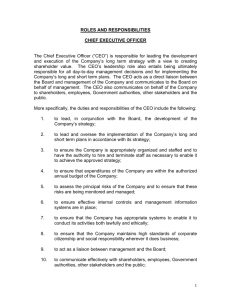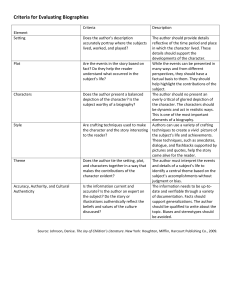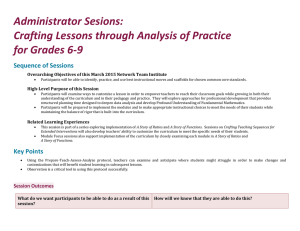The managerial process of crafting and executing strategy
advertisement
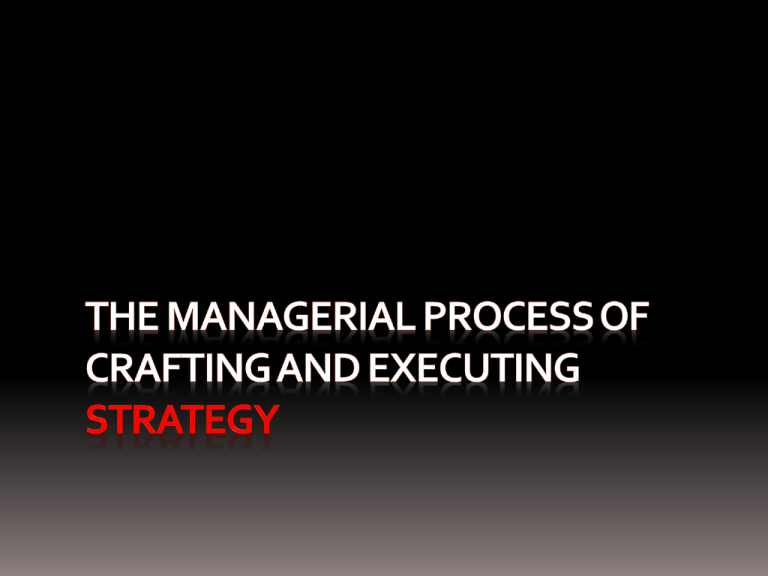
The strategy making, strategy executing process Developing a Strategic Vision Setting Objective Crafting a strategy to achieve the objectives and vision Implementi ng and Executing the strategy Revise as needed in light of actual performance, changing conditions, new opportunities and new ideas Monitoring developments, evaluating performance and making corrective adjustments. Strategic Vision The route acompany intends to take in developing and strengthening its business. It lays out the company’s strategic course in preparing for the future Developing a Strategic Vision Internal Consideration What are the company’s ambitions? What industry standing should the company have? Will the company’s present business generate sufficient growth and profitability in the years ahead to please shareholders? What organizational strengths ought to be leveraged in terms of adding new products or services and getting into business Is the company stretching its resources too thin by trying to compete in too many markets or segments, some of which are unprofitable? Is the company’s technological focus too board or too narrow? Are any changes needed? Strategic vision as a managerial tool Must provide understanding of what management wants its business looklike Must provide managers with a reference point in making strategic decisions and preparing the company for the future Must say something definitive about how the company’s leaders intend to position the company beyond where it is today Characteristic of an effective worded strategic vision Graphic Directional Focused Flexible Feasible Desirable Easy to communicate What covers compare to mission statement Strategic Vision is the company’s future strategic course, the direction we are headed and what our future product/market/ customer/technology focus will be (where we are going) Mission statements provide a brief overview of the company’s present business purpose and raison d’etre (who we are, what we do and why we are here) Communication the strategic vision An effectively communicated vision is a valuable management tool for enlisting the commitment of the company’s personnel to actions that get company moving in the intended direction Expressing the essence of the vision in a slogan Breaking down the resistance to a new strategic vision Recognizing Strategic Inflection Point Understanding the payoffs of a clear vision statement Setting Objective Setting Objective Objectives are an organization’s performance targets – the result and outcomes management wants to achieve. The function as a yardsticks for measuring how well the organization is doing Setting stretch objectives to avoid ho-hum result Need for a balanced score card Strategic performance foster better financial performance Financial performance are lagging indicators where strategic performance signs of leading indicators Expressed Strategic intent as the “contract” of the management Objective setting needs to be top-down rather than bottom-up Crafting a strategy to achieve the objectives and vision Strategy crafting Masterful strategies come mostly by doing thing differently from competitors where it counts – out innovating them, being more efficient , being more imaginative, adapting faster In most company crafting and executing strategy is a team effort in which every manager has a role for the area he or she heads. Giving people an influential stake in crafting the strategy they must later help implement and execute not only builds motivation and commitment but also means those people can be held accountable for putting the strategy into place and making it work – the excuse of “it wasn’t my idea to do this” won’t fly Start at the top Mid-level and front-line managers cannot craft unified strategic moves without understanding the company’s long-term direction and knowing the major components of the overall and business strategies that their strategy making efforts are supposed to support and enhance Company’s Strategy Making Hierarchy CEO & other senior executive General managers, different line business Major functional activities Operating managers Corporate Strategy Business Strategy • The companywide game plan for managing asset of business • How to strengthen market position and built competitive advantage • Action to build competitive capabilies Functional area Strategy • Add relevant detail to the hows of overall business strategy • Game plan for managing a particular activity Operating Strategy • Add detail and completeness to business and functional strategy • Managng specific lower echelon Cause of disarray strategies Weak leadership Too few strategy guidelines coming from top Less unified collection strategies Less communicated vision, personnel doesn’t buy in the company’s longterm direction and overall strategy Less review (due-dilligence) of lower level strategies for consistency supported of higher level strategy (synchronization, adjustment on both direction may needed) Strategic Plan Consists of Company’s future direction (strategic vision), performance targets and Stragegy to achieved Implementi ng and Executing the strategy Strategy Execution is an Operations oriented The activities that ‘make-things-happen’ The most demanding and time consuming part of the strategy management process Each manager has to answer to, “what has to be done in my area to execute my piece of the strategic plan, and what actions should I take to get the process underway” Can take several months to several years Principal aspect s of strategy execution Staffing with needed skill and expertise Allocation of resources, esp. at the critical point to success Policies and procedures Best practises, continuous improvement, reassess Installing information and operating system foe enabling better carry out Motivating people, modifying duties if needed Rewards and incentives Culture and conducive work climate Exerting the internal leadership Monitoring developments, evaluating performance and making corrective adjustments. Revise as needed in light of actual performance, changing conditions, new opportunities and new ideas Strategy monitoring issues Managing strategy is an ongoing process, not an every now and then task. A company’s vision, objectives, strategy and approach to strategy execution are never final If downturn in performance, whether related to poor strategy or to poor execution or both? All have to be revisited antime Role of board directors (komisaris, Ind) Be inquiring, critics and ovesee the company’s direction, strategy, and business approaches Evaluate the caliber of the executive’s strategy making and strategy executing skills Institue a compensation plan for top executives that rewards them for actions and results that serve stakeholder interests, and most especially those of shareholders Oversee the company’s financial accounting and financial practices Equipped with strong independent directors Well informed about company’s performance Guides and judges the CEO and other executives Has the courage to curb inappropriate or unduly risky management actions Certifies to shareholders that the CEO is doing what the board expects Intensely involved in debating the pros and cons of key decisions and actions Do not being a rubber-stamp of the CEO


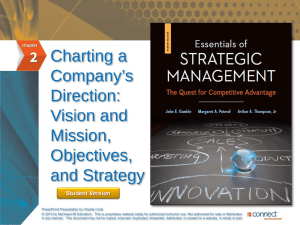
![Strategic Management Process [ PPT – 313 KB ]](http://s2.studylib.net/store/data/010103956_1-62ba32a889edaee1cb691f1ec7a63aa5-300x300.png)

